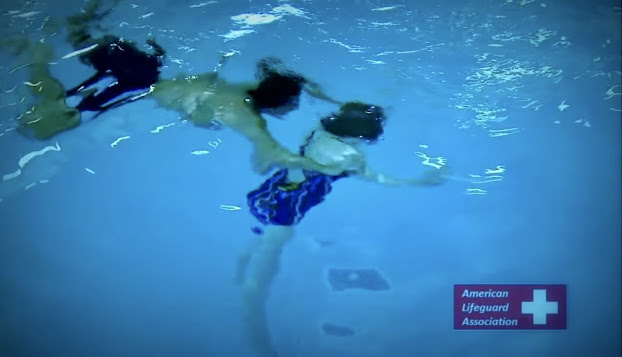What to Expect From Lifeguard Training
Lifeguard training certifications vary slightly depending on the organization, but most programs require candidates to pass written exams, demonstrate water rescue skills, and meet physical fitness standards. Let's take a closer look at what each component entails.
Written Exams
Most certifications include a written exam that covers first aid, CPR, injuries, patron surveillance techniques, and emergency action plans. The exams are open-book multiple choice tests, but you'll need to study the course materials in-depth to ensure you remember all of the protocols and procedures. On average, the pass rate for written exams is around 85%.
Water Rescue Skills
The water rescue skills assessment is often cited as the most physically demanding part of lifeguard training. Candidates are expected to demonstrate strong swimming abilities and handle a variety of in-water rescues. You'll typically be evaluated on front and back crawl strokes, treading water, diving to retrieve objects, carriage assists, towel drags, and spinal injury transfers. Many fail this portion due to fatigue or inability to complete strenuous skills like spinal transfers.
Physical Fitness Requirements
To be an effective lifeguard, you need athletic endurance and speed to respond quickly in emergency situations. As a result, most certifications require candidates to pass a physical screening to prove they have the stamina for the job. Common benchmarks include 500 yards of continuous swimming under 12 minutes, 20-30 repetitions of spinning rescues or dummy drags, and tread water for 2-5 minutes without using hands to rest on the pool wall. The physical demands weed out nearly 15% of trainees.
Other Challenges of Lifeguard Training
Beyond the explicit testing components, lifeguard certification courses pose additional difficulties that can trip up unprepared candidates. Here are a few other hurdles to keep in mind:
Long Hours in the Water
Many programs schedule 6-8 hours per day of in-water instruction and practice, mimicking the prolonged physical demands of an actual lifeguard shift. Fatigue starts to set in after a few days, especially if you're not used to that level of swimming and exertion. Staying properly fueled and hydrated is crucial.
Strict Instructors
Lifeguard trainers are understandably serious since lives may depend on your abilities someday. They will push your limits and expect perfection on skills demonstrations. Any deviations result in repeat practice until you pass standards. Their high expectations weed out over half of enrollees lacking dedication or capability.
Information Overload
Much like other safety certifications, the courses pack an immense amount of policies, procedures, and protocols into a short period. Absorbing it all while also mastering physical skills is cognitively draining. Many trainees struggle to retain details under pressure of timed tests. Effective note-taking is key.
Is Lifeguard Training Too Difficult?
If you have the right preparation, dedication, and work ethic, most individuals can achieve lifeguard certification with sufficient practice. However, the programs aim to simulate real working conditions as much as possible, so a moderate level of physical fitness, swimming ability, and comfort in the water are prerequisites for success. Those lacking in one or more areas may find the training disproportionately challenging.
Some warning signs you may struggle include: inefficient swimming strokes, inability to float or tread water for extended periods, poor cardiovascular endurance, difficulty reading or following procedures under stress, or previous injury affecting pool-deck mobility. But with targeted training leading up to your course, even moderate swimmers can gain the necessary fitness.
The key is going in with realistic expectations of the intensity and commitment lifeguarding demands. Most certifying agencies have pass rates between 50-70%, so be prepared to fully exert yourself and potentially repeat portions if needed. With dedication and hard work focused on your weaknesses, lifeguard certification is certainly attainable for driven candidates willing to put in the effort.
Resources for Preparing for Lifeguard Training
If after considering your attributes and abilities you feel up for the challenge, here are some recommendations for optimizing your chances of success:
- Take swim lessons to improve weaker strokes like treading and carrying/towing techniques. Many community centers offer low-cost stroke-specific adult classes perfect for this goal.
- Follow a custom 8-12 week pre-certification training program including lap and interval swimming, calisthenics, and water based exercises to build the right muscle groups and cardio capacity.
- Seek coaching to learn competitive swimming starts and turns which will translate to swiftly entering the water during simulations.
- Shadow a working lifeguard on their shifts whenever possible to better understand practical rescues, surveillance methods, and general on-deck responsibilities.
- Utilize the American Lifeguard Association website, www.americanlifeguard.com, which has a searchable database of open certification courses and skills preparation checklists.
Making a concerted effort to shore up weak points and go into training at your physical peak will give you the best shot at achieving lifeguard certification on the first attempt. The more you prepare, the greater your chances of handling the demands. A little extra work up front pays off in gaining this rewarding credential.






0 Comments